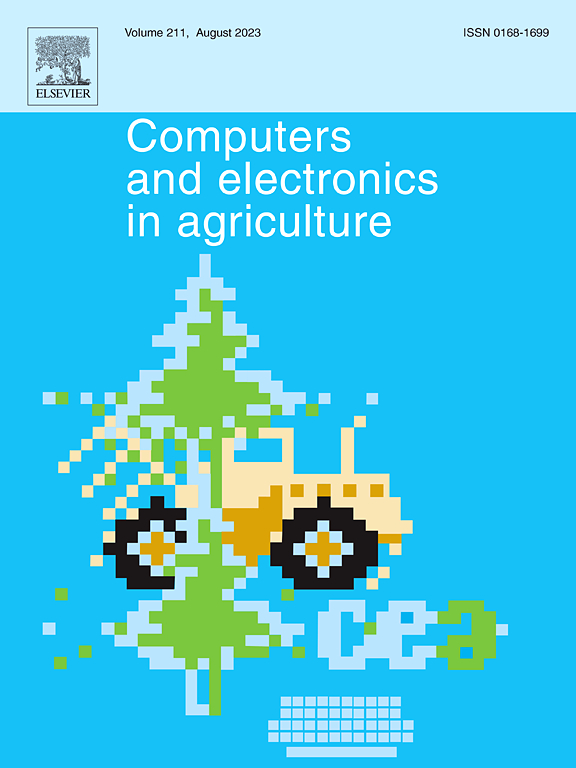基于多尺度特征融合网络的水产养殖对虾幼虫检测与计数
IF 8.9
1区 农林科学
Q1 AGRICULTURE, MULTIDISCIPLINARY
引用次数: 0
摘要
对虾幼虫的准确检测和计数对对虾养殖系统的有效管理和优化至关重要。然而,现有的方法往往在高密度环境中失败,在高密度环境中,幼虫表现出显著的尺寸变化和重叠,导致高错误率,降低了在现实场景中的适用性。为了解决这些挑战,我们提出了一个新的框架,该框架将尺寸自适应密度图生成与多尺度特征融合网络(MFFN)相结合,专门为水产养殖的密集和复杂条件而设计。该方法根据图像中虾仔大小的变化动态调整密度图的生成,提高了精度,提高了检测精度。同时,MFFN架构在多个尺度上提取关键特征,使模型即使在拥挤且遮挡严重的场景中也能准确地检测和计数幼虫。通过结合这些技术,该框架在不同的水产养殖环境中表现出卓越的适应性和鲁棒性。在一个综合的对虾幼虫数据集上进行的大量评估表明,该方法的检测准确率为93.68%,显著优于传统方法。该模型还降低了错误率,提高了精确度和召回率,视觉结果显示了它区分和准确计数不同大小幼虫的能力。这项工作为对虾幼虫的自动化监测提供了有价值的解决方案,支持可持续的水产养殖实践。未来的研究将探索该模型的更广泛应用,并进一步改进以增强可扩展性。本文章由计算机程序翻译,如有差异,请以英文原文为准。
Shrimp larvae detection and counting in aquaculture using multiscale feature fusion networks
Accurate detection and counting of shrimp larvae are essential for effective management and optimization of shrimp aquaculture systems. However, existing methods often fail in high-density environments, where larvae exhibit significant size variations and overlap, leading to high error rates and reduced applicability in real-world scenarios. To address these challenges, we propose a novel framework that integrates size-adaptive density map generation with a multiscale feature fusion network (MFFN), specifically designed for the dense and complex conditions of aquaculture.
The proposed approach dynamically adjusts density map generation based on the varying sizes of shrimp larvae within an image, improving precision and enhancing detection accuracy. Simultaneously, the MFFN architecture extracts critical features across multiple scales, enabling the model to accurately detect and count larvae even in crowded scenes with significant occlusion. By combining these techniques, the framework demonstrates superior adaptability and robustness across diverse aquaculture environments.
Extensive evaluations on a comprehensive shrimp larvae dataset show that our method achieves a detection accuracy of 93.68, significantly outperforming traditional approaches. The model also reduces error rates and improves precision and recall metrics, with visual results showcasing its ability to distinguish and accurately count larvae of varying sizes. This work provides a valuable solution for automated shrimp larvae monitoring, supporting sustainable aquaculture practices. Future research will explore broader applications of the model and further refinements for enhanced scalability.
求助全文
通过发布文献求助,成功后即可免费获取论文全文。
去求助
来源期刊

Computers and Electronics in Agriculture
工程技术-计算机:跨学科应用
CiteScore
15.30
自引率
14.50%
发文量
800
审稿时长
62 days
期刊介绍:
Computers and Electronics in Agriculture provides international coverage of advancements in computer hardware, software, electronic instrumentation, and control systems applied to agricultural challenges. Encompassing agronomy, horticulture, forestry, aquaculture, and animal farming, the journal publishes original papers, reviews, and applications notes. It explores the use of computers and electronics in plant or animal agricultural production, covering topics like agricultural soils, water, pests, controlled environments, and waste. The scope extends to on-farm post-harvest operations and relevant technologies, including artificial intelligence, sensors, machine vision, robotics, networking, and simulation modeling. Its companion journal, Smart Agricultural Technology, continues the focus on smart applications in production agriculture.
 求助内容:
求助内容: 应助结果提醒方式:
应助结果提醒方式:


